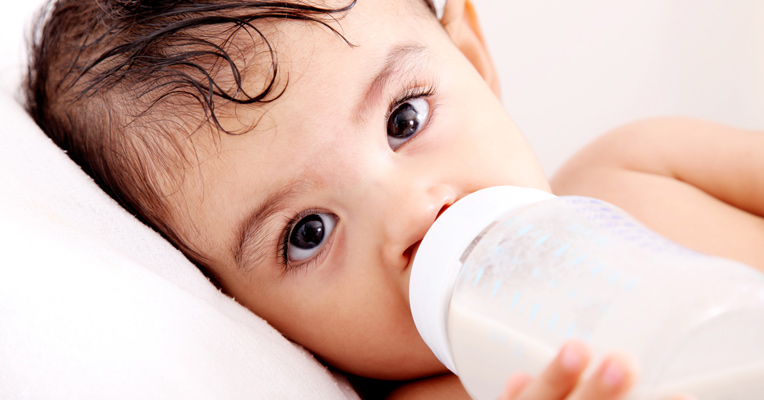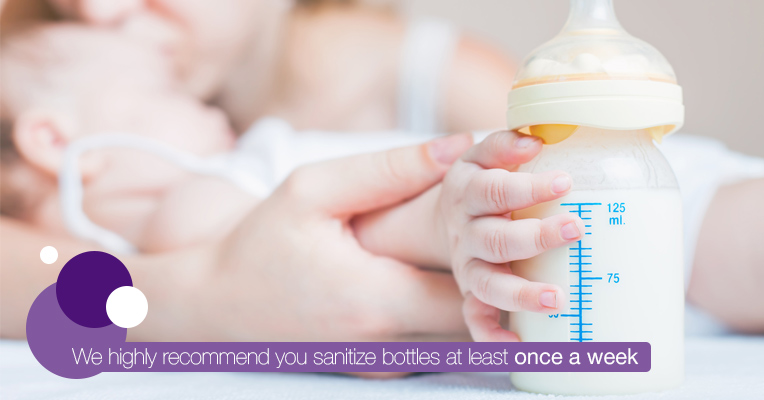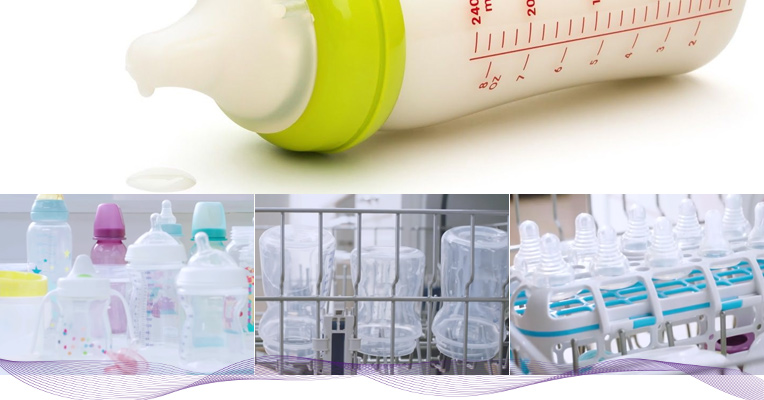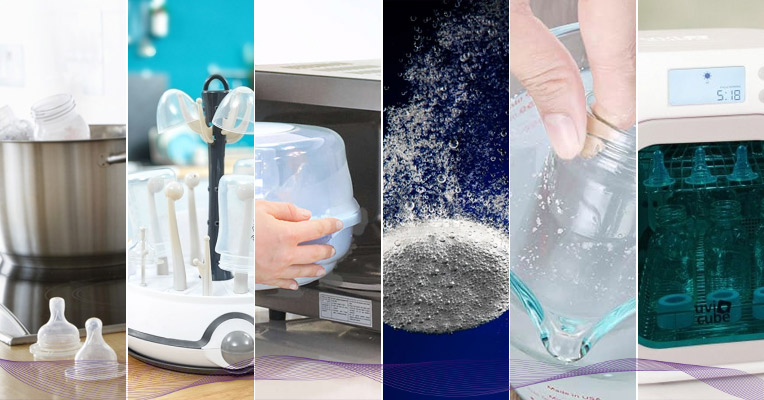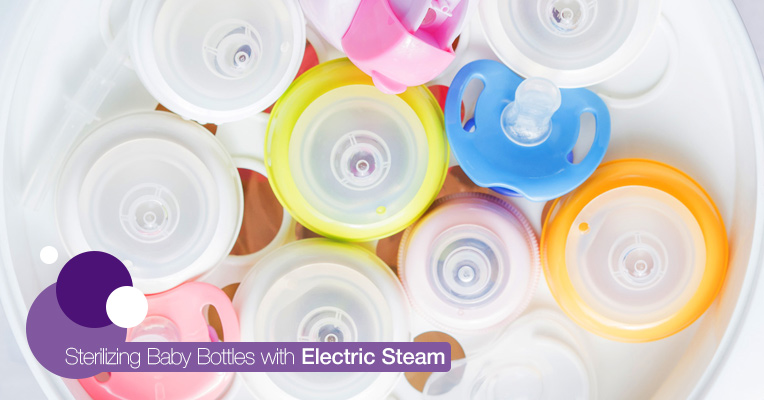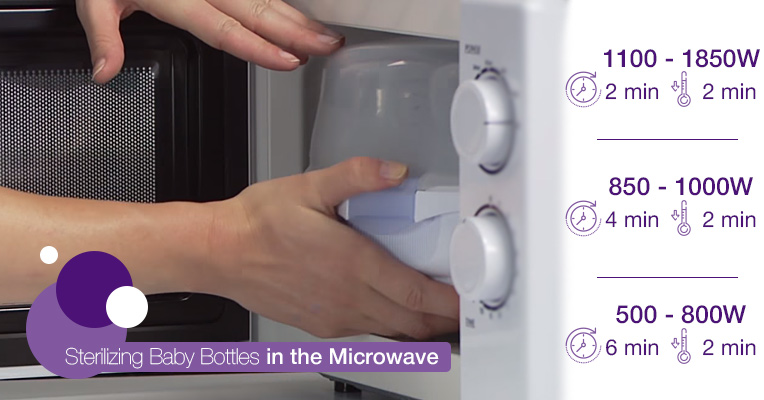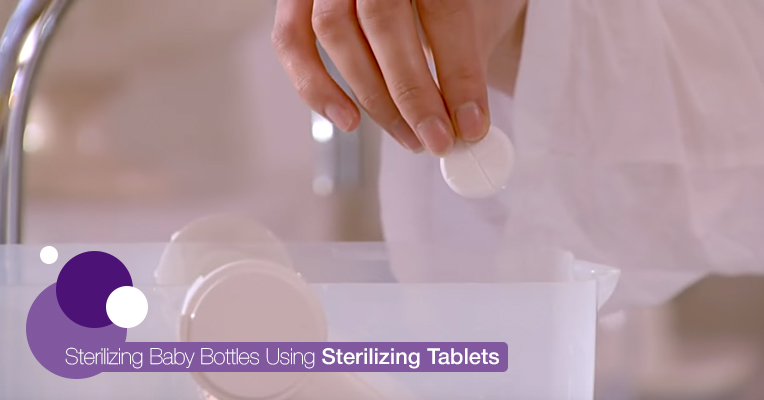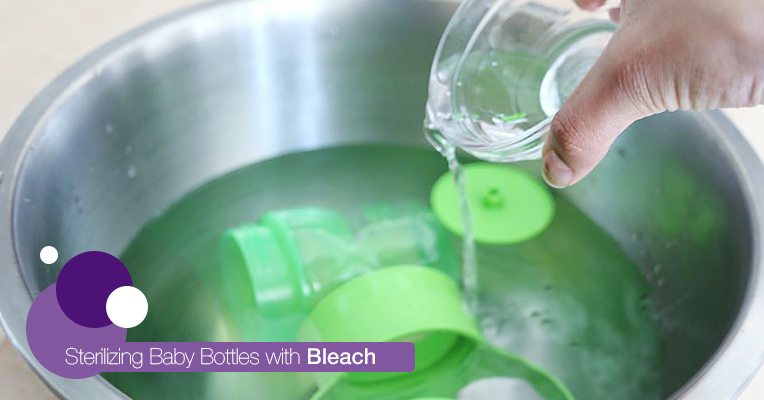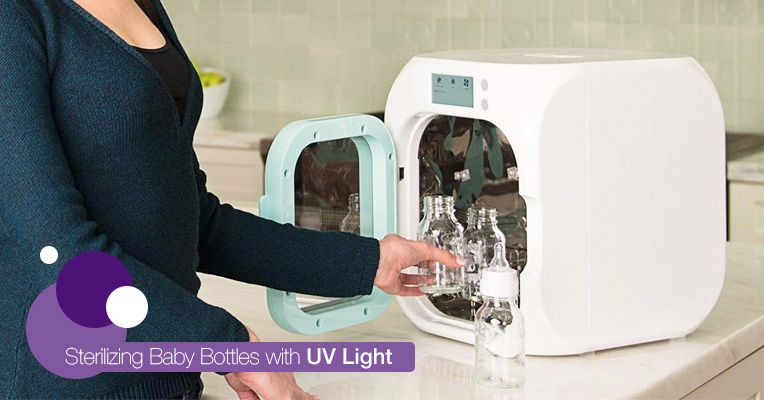After you’ve finally done thorough research and chosen baby containers, bottles and a bottle warmer for them, there’s one more step to consider - how to clean them properly. Almost all water supplies are reliably clean nowadays, so cleaning bottles with soap and tap water is safe and can help you get rid of almost all germs... but not all. Bacteria can grow very quickly inside the bottles, especially if you usually store milk in them. And if you forget a baby bottle somewhere from time to time or just neglect to clean it timely, you must be really concerned about hazardous bacteria. In this case, sterilizing is vitally important. It’s not enough to just clean those bottles with water, otherwise, this might lead to some infections, particularly diarrhea and vomiting. That said, there are some other instances when you have to sterilize baby bottles:
- No matter whether you’ve got plastic, silicone, or glass bottles, you should sterilize them before the very first use. Brand new bottles MUST be sterilized, since they might be coated in some kinds of chemicals, let alone handled by different people during production.
- If you’re going to use a second-hand bottle or borrow one from your friend, it’s critical to sterilize it as well. Even if the bottle was pre-used by older siblings of a baby, it still needs thorough sterilization.
- If you travel and don't have access to reliable water supply, it’s also important to sterilize a bottle before every use. This will help you avoid buildup of harmful microbes, bacteria, or fungi.
Many moms sterilize bottles with nipples, rings, and caps only when they take them out of the package. Beyond that first use, they never sterilize bottles again. They just wash them with soap and hot water from that point on. Pediatricians approve that hot soapy water or a long cycle in the dishwasher is more than enough to remove germs and any other buildup from bottles. And even if you often sterilize your bottles, they can still be exposed to bacteria and dirt before your child actually uses them. So, how often to sanitize bottles is up to you. Yet, we highly recommend you sanitize bottles at least once a week or:
- If your baby has been sick for some time, it’s important to sterilize the bottle after an illness. This will help you prevent re-infecting your child by using unclean gear. The same goes for pacifiers.
- If a baby was premature or has a weak immune system. According to the CDC (Center for Disease Control and Prevention), sterilization is essential before each use until your baby reaches 3 months. The baby’s immune system gets fully developed when your baby reaches one year. Only then, he or she will become less susceptible to various infections. Therefore, cleanliness is very important when preparing formula or breastmilk bottles. The same is true for everything that goes into your baby’s mouth.
We hope that we’ve helped you to find out more about the importance of sterilizing. And now we will try to guide you through the cleaning and sterilizing processes.
Water, breast milk, and baby formulas are susceptible to contamination if you don’t clean bottles and supplies properly. For daily cleaning, you'll only need soap or mild detergent, hot water, and a scrubbing brush. You don’t need to worry about the quality of tap water, it’s as safe for your child as it is for you unless you use some questionable supply of water, of course. After each feeding, you can clean bottles manually or throw them into a dishwasher. If you decide to clean them by hand, you should:
- Wash hands with soap and water thoroughly.
- Take apart all bottle elements including the bottle itself, nipple, cap, ring, and valve.
- Rinse all the parts by holding them under running water to remove any milk particles. Try not to set them into the sink, as this might lead to cross-contamination. It would be sensible to get a dedicated container and dip your bottles there. The rising water can be either warm or cold.
- Put all water parts into a clean bowl, basin, or another special container for feeding equipment. Fill it with hot water and add soap or mild detergent.
- Thoroughly scrub everything using the brush aimed for infant feeding items only. Сlean all the way down to the bottom of the bottle. After cleaning, squeeze water through the nipple to make sure it’s not clogged. Rinse everything again under warm water.
- Allow bottle parts to air-dry completely. Place bottle parts on a clean dishcloth or towel. Do not rub items if you don’t want to transfer any germs. Just allow your baby bottle to air dry.
- Also, don’t forget to rinse the basin and bottle brush after each cleaning. It’s advisable to wash them twice a week with soap and warm water. If your infant is less than 3 months, wash basin and brush after each use.
If you own a dishwasher, you can safely clean your feeding bottles there.
- For starters, separate all bottle parts and rinse them under running water.
- Then, place them in your dishwasher. Put small items into a closed-top basket so that they won’t end up in the filter. If you wish, you can run the sanitizing setting. The hottest water and a heated drying cycle can kill almost all germs and effectively sterilize the bottles.
- When the cycle is complete, remove items from a dishwasher. If they aren’t completely dry, put them on a clean towel and let them air dry thoroughly.
Remember that cleaning is essential before sterilizing.
There are different ways of how you can sanitize baby’s feeding equipment at home. They include:
- Sterilizing with boiling water
- Sterilizing with electric steam
- Sterilizing in the microwave
- Sterilizing with special sterilizing tablets
- Sterilizing with bleach
- Sterilizing with UV light
This is the most popular way of sanitizing milk bottles, as it requires no special equipment. All you need is tap water and a pot. To perform sanitizing, you need:
- Fill a clean pot with water.
- Submerge the freshly-cleaned bottle parts in the water upside down. Make sure that there are no air bubbles at the bottom.
- Put the pot over heat and let the water to a boil.
- Boil your bottles for at least 5-10 minutes depending on the manufacturer’s recommendations.
- Turn the heat off and then remove bottle parts using clean tongs.
- You can also use the tongs to push the bottle parts down into the water during boiling. Place everything on a dry cloth.
There are several main types of sterilizers, but all of them work by using high temperatures to kill germs and mold on feeding bottles and nipples. Pretty much like boiling. Yet, some electric sterilizers can also deodorize and dry baby bottles with hot air afterwards. Electric steamers come in different shapes and some of them can sterilize a lot of bottles and other baby supplies at a time. The principle of operation is very simple - just load your bottle parts, plug in the sterilizer, and walk away. The only thing to note is that you’ll need to put bottles and teats with the openings facing downwards for the best sanitizing results.
You might be surprised, but your microwave can double as a quick and effective sanitizer for your baby’s bottle. It offers you two different methods of sterilization.
- The easiest way is to use a microwave steam sterilizer (if it has one) or put a large container with some water and baby bottles. Just toss a container into your microwave, set the highest setting for a minute, and relax. Once your microwave beeps, you can collect your sterile bottles, nipples, and caps.
- The other way requires more efforts and careful balancing. Firstly, wash the bottles as usual before sanitizing. Fill each bottle with water halfway and place them upright into the oven. Microwave at the highest setting for a minute and a half. To sanitize the nipples and rings place them in a bowl with water and run the microwave for the same 1.5 minutes.
Whatever way you choose, make sure your microwave is clean and has no food splatters inside.
If you’re away from home, sterilizing tablets or other disinfectant solutions might be a way out. They are just as effective at removing bacteria as other sterilization methods mentioned in our article. Be sure to follow these simple steps and manufacturer’s instructions for proper sterilization:
- Thoroughly clean bottles, caps, teats, and utensils before sterilization.
- Follow the manufacturer’s guidelines for making up the solution.
- Place the baby feeding supplies in this solution, making sure everything is immersed in water completely, without air bubbles.
- Leave the feeding equipment in the solution for the recommended time (about 30 minutes). If you wish, you can then leave baby bottles in the solution until you need them. Nothing wrong will happen.
- Take out bottles, teats, and lids and allow them to drain completely. Keep away from rinsing off the sterilizing solution.
- Dispose of the solution after 24 hours maximum. Clean the container with warm, soapy water.
If you can’t boil or use any other of the described methods, you can prepare a bleach solution for cleaning baby bottles.
- Mix 1 teaspoon of unscented bleach with 16 cups of water in a clean bowl or wash basin.
- Soak bottles in this solution for 2-5 minutes. Avoid air bubbles in the bottom of the bottles.
- Squeeze bleach solution through nipple holes.
- Remove your bottles with clean hands or tongs. Place them on a clean dish towel and let them air dry. There’s no need to rinse the bottles since the remaining bleach will break down as it dries.
The method of sterilizing baby bottles with UV light is relatively new. Though, the baby market already offers different UV sanitizers designed specifically for baby bottles. They are large enough to accommodate whole bottles, not only pacifiers and similar small stuff. Still, they are portable enough to take on long-haul car trips where other sterilizing options are not available.
UV sanitizers are very easy to use - you just need to load the pre-cleaned bottles and turn the unit on. It uses the powerful ultraviolet light that can kill viruses, mold, and bacteria in less than 3 minutes. Plus, when your baby outgrows the bottle stage, you can use this appliance for sanitizing small plastic toys and teething rings. That’s how you can stretch a dollar.
Safety Tips
- Never leave boiling water unattended or within the reach of your children.
- Hot steam can burn you just like boiling water. So, it's better to leave bottles in the steam sterilizer or pan for a while or until you actually need them. As soon as you take them out, put the teats and caps on the bottles.
- If you use chemicals or sterilizing tablets, keep them out of reach.
- Always wash your hands before touching freshly-sterilized baby bottles. Better yet, you can use clean tongs. Assemble baby bottles on a clean surface.
Although pediatricians aren’t as concerned with sterilizing as they were a dozen of years ago, in light of increased concern over food safety, we recommend you to continue sterilizing feeding equipment until your child is at least 12 months old. After the age of one, the immune system of your little one is strong enough to provide a high tolerance to germs. Still, it doesn’t mean that they aren’t susceptible to bacterial infections at all. “Prevention is better than cure”, so many moms sleep easier if the milk bottles are sterilized regularly even after the first year of baby’s life. They stop sterilizing nipples when a baby stops using them. So, it’s up to you to decide for how long you want to disinfect your baby’s bottles and pacifiers. The only thing you should take into account that as soon as you notice any damage (cracking, chipping, breaking, etc) or signs of wear and tear, you must immediately replace the bottle. Nipples might need to be replaced even more often than the bottles. If you notice discoloration, swelling, thinning, cracks or sticky texture, it means that the nipple has already worked its days out.
